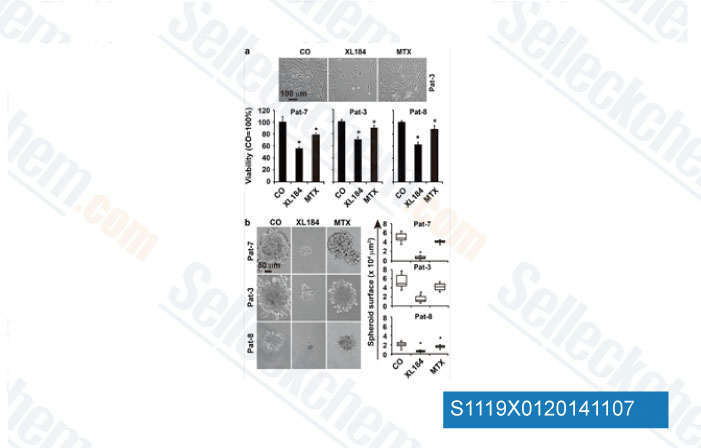|
Toll Free: (877) 796-6397 -- USA and Canada only -- |
Fax: +1-832-582-8590 Orders: +1-832-582-8158 |
Tech Support: +1-832-582-8158 Ext:3 Please provide your Order Number in the email. |
Technical Data
| Formula | C28H24FN3O5 |
|||
| Molecular Weight | 501.51 | CAS No. | 849217-68-1 | |
| Solubility (25°C)* | In vitro | DMSO | 100 mg/mL (199.39 mM) | |
| Water | Insoluble | |||
| Ethanol | Insoluble | |||
|
* <1 mg/ml means slightly soluble or insoluble. * Please note that Selleck tests the solubility of all compounds in-house, and the actual solubility may differ slightly from published values. This is normal and is due to slight batch-to-batch variations. * Room temperature shipping (Stability testing shows this product can be shipped without any cooling measures.) |
||||
Preparing Stock Solutions
Biological Activity
| Description | Cabozantinib (XL184) is a potent VEGFR2 inhibitor with IC50 of 0.035 nM and also inhibits c-Met, Ret, Kit, Flt-1/3/4, Tie2, and AXL with IC50 of 1.3 nM, 4 nM, 4.6 nM, 12 nM/11.3 nM/6 nM, 14.3 nM and 7 nM in cell-free assays, respectively. Cabozantinib induces PUMA-dependent apoptosis in colon cancer cells via AKT/GSK-3β/NF-κB signaling pathway. | ||||||
|---|---|---|---|---|---|---|---|
| Targets |
|
||||||
| In vitro | XL184 has weak inhibitory activity against RON and PDGFRβ with IC50 of 124 nM and 234 nM, respectivey, and has low activity against FGFR1 with IC50 of 5.294 μM. [1] XL184 at low concentration (0.1-0.5 μM) is sufficient to induce marked inhibition of constitutive and inducible Met phosphorylation and its resultant downstream signaling in MPNST cells, and inhibit HGF-induced MPNST cell migration and invasion. XL184 also induces marked inhibition of Met and VEGFR2 phosphorylation in cytokine-stimulated human umbilical vein endothelial cells (HUVECs). Although XL-184 has no significant effect on MPNST cell growth at 0.1 μM, XL184 at 5-10 μM significantly inhibits the MPNST cell growth. [2] | ||||||
| In vivo | XL184 treatment at 30 mg/kg in RIP-Tag2 mice with spontaneous pancreatic islet tumors disrupts 83% of the tumor vasculature, reduces pericytes and empty basement membrane sleeves, causes widespread intratumoral hypoxia and extensive tumor cell apoptosis, and slows regrowth of the tumor vasculature after drug withdrawal, more significantly compared with XL999 that blocks VEGFR but not c-Met, leading to only 43% reduction in vascularity, suggesting that concurrent inhibition of VEGFR and other functionally relevant receptor tyrosine kinases (RTK) amplifies angiogenesis inhibition. XL184 also decreases invasiveness of primary tumors and reduces metastasis. [1] XL184 at 30 mg/kg/day significantly abrogates human MPNST xenografts growth and metastasis in SCID mice. [2] Administration of XL184 induces dose-dependent inhibition of tumor growth in breast, lung, and glioma tumor models, in association with decreased tumor and endothelial cell proliferation as well as increased apoptosis. A single oral dose of XL184 is sufficient to induce sustained tumor growth inhibition in MDA-MB-231 tumor-bearing mice and C6 tumor-bearing rats at 100 mg/kg and 10 mg/kg, respectively. [3] |
Protocol (from reference)
| Cell Assay: |
|
|---|---|
| Animal Study: |
|
References
|
Customer Product Validation

-
Data from [Data independently produced by Cancer Discov, 2014, 4(7), 816-27]

-
Data from [Cell Death Dis, 2014, 5, e1471]

-
Data from [Data independently produced by Liver Int, 2014, 10.1111/liv.12524]

-
, , Christina W Yde/CDM Danish Cancer Society Research Center Denmark
Selleck's Cabozantinib (XL184) has been cited by 158 publications
| Construction of disulfidptosis-based immune response prediction model with artificial intelligence and validation of the pivotal grouping oncogene c-MET in regulating T cell exhaustion [ Front Immunol, 2024, 15:1258475] | PubMed: 38352883 |
| Vepafestinib is a pharmacologically advanced RET-selective inhibitor with high CNS penetration and inhibitory activity against RET solvent front mutations [ Nat Cancer, 2023, 4(9):1345-1361] | PubMed: 37743366 |
| Multiplexed kinase interactome profiling quantifies cellular network activity and plasticity [ Mol Cell, 2023, 83(5):803-818.e8] | PubMed: 36736316 |
| Anti-hepatocellular carcinoma activity of the cyclin-dependent kinase inhibitor AT7519 [ Biomed Pharmacother, 2023, 164:115002] | PubMed: 37311277 |
| Impact of tumor suppressor genes inactivation on the multidrug resistance phenotype of hepatocellular carcinoma cells [ Biomed Pharmacother, 2023, 165:115209] | PubMed: 37499450 |
| Anti-hepatocellular carcinoma activity of the cyclin-dependent kinase inhibitor AT7519 [ Biomed Pharmacother, 2023, 164:115002] | PubMed: 37311277 |
| Relevance of the organic anion transporting polypeptide 1B3 (OATP1B3) in the personalized pharmacological treatment of hepatocellular carcinoma [ Biochem Pharmacol, 2023, 214:115681] | PubMed: 37429423 |
| Role of organic cation transporter 3 (OCT3) in the response of hepatocellular carcinoma to tyrosine kinase inhibitors [ Biochem Pharmacol, 2023, 217:115812] | PubMed: 37722628 |
| Validation of miRNAs as diagnostic and prognostic biomarkers, and possible therapeutic targets in medullary thyroid cancers [ Front Endocrinol (Lausanne), 2023, 14:1151583] | PubMed: 37361540 |
| Cabozantinib inhibits HBV-RNA transcription by decreasing STAT3 binding to the enhancer region of cccDNA [ Hepatol Commun, 2023, 10.1097/HC9.0000000000000313] | PubMed: 37938099 |
RETURN POLICY
Selleck Chemical’s Unconditional Return Policy ensures a smooth online shopping experience for our customers. If you are in any way unsatisfied with your purchase, you may return any item(s) within 7 days of receiving it. In the event of product quality issues, either protocol related or product related problems, you may return any item(s) within 365 days from the original purchase date. Please follow the instructions below when returning products.
SHIPPING AND STORAGE
Selleck products are transported at room temperature. If you receive the product at room temperature, please rest assured, the Selleck Quality Inspection Department has conducted experiments to verify that the normal temperature placement of one month will not affect the biological activity of powder products. After collecting, please store the product according to the requirements described in the datasheet. Most Selleck products are stable under the recommended conditions.
NOT FOR HUMAN, VETERINARY DIAGNOSTIC OR THERAPEUTIC USE.
